Escayrac was renowned in his day as a sometime diplomat, explorer/traveler (Africa, Turkey, the Far East), scholar (savant was the contemporary term), author, celebrity. He was now living in England after a personally disastrous trip to China (described further below) where, as a prisoner, he had been tortured and lost usage of his hands (he now wrote only by dictation).
That fateful engagement resulted in several papers and books on China, including Escayrac’s multi-volume Mémoires sur la Chine (1864-65), and the work on language and telegraphy that occupied him in his last years. The work on language is scattered, offering not a single theory of communication but rather several different ideas around (1) signals (whether electrical, visual, or written) and (2) the classification of phrases/ideas to aid telegraphic transmission of messages. There was also a (confused) (3) overlap of ideas from both of those realms (signals, semantics).
Tables were at the heart of Escayrac’s conceptions of telegraphy: arrangement of phrase elements in semantic grids, of Chinese character components, and even of his tekachotomical
method of writing. The principle of the table that underlay all of this work may well have derived from his work on telegraphic transmission of Chinese; there is no evidence of it in his previous writing. It is Escayrac’s semantic tables — the heart of his universal telegraphy
— that are of greatest interest to this student.
Escayrac’s work on telegraphy was noted but dismissed in its time, and led nowhere, really. Yet it remains fascinating, for the visual appeal of its tabular presentation, for its utopian (almost Saint-Simonian) ambitions, for its energetic inventiveness.
subject tables
Start with the simple —
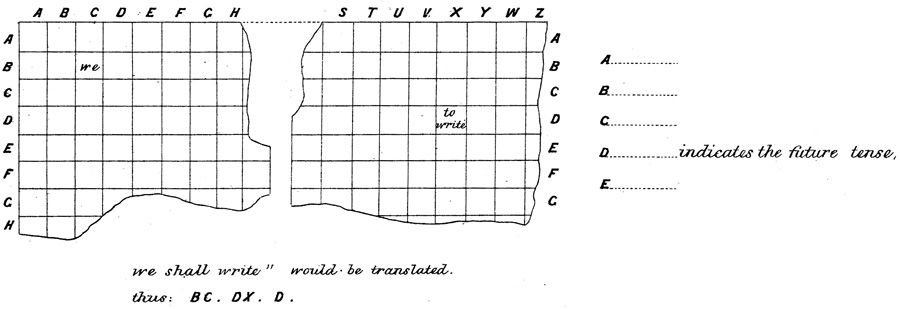
drawing (rearranged), Escayrac de Lauture, GB Patent No. 2225 Signalling
(1862)
(the final D indicating future tense).We shall write
would be translated thus: BC . DX. D.
The basic idea is clear enough. Phrases are arrayed in tables, each phrase having a unique address. Here, the addresses are biliterals; they might also be something like Morse or flag code, or any code representing the intersection of a column and row. In his Analytic Universal Telegraphy (1862), Escayrac proposes a 15-page manual, each page containing a table (half a foot square
) devoted to a subject domain, e.g., commercial correspondence or military intelligence. Each of these different subject sheets might possess a vocabulary of 450-600 words/phrases.
This illustration provides a sense of how several tables would be used —
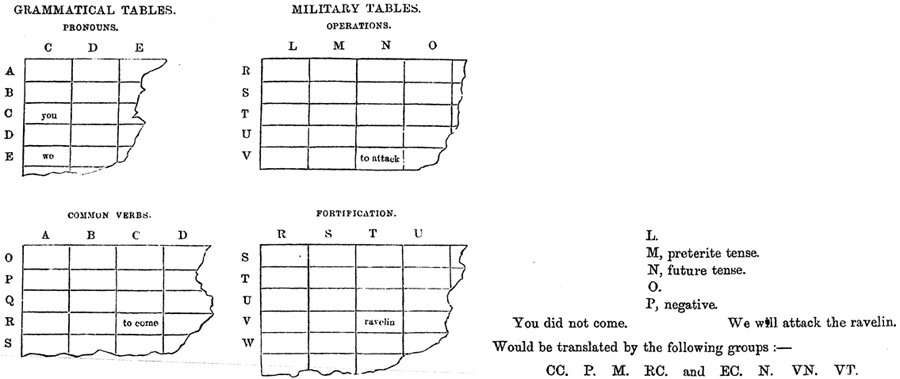
rearranged, from Specimen of the tables, with letters, and the mode of using them
, Escayrac de Lauture, Analytic Universal Telegraphy (1862)
In the example immediately above, right, the expression ravelin
floats in a not-yet-populated field of terms. Ravelin is a triangular embanked salient located outside the ditch of a fortress
(American Heritage Dictionary). Presumably the cells surrounding the term would contain other terms associated with fortifications. (There is something plaintive about that You did not come,
incidentally, in light of Escayrac’s captivity; and something vengeful about the second example We will attack the ravelin,
with respect to the victory of the Anglo-French force over the Qing Army in Beijing, in September 1860.)
So we turn to the vocabularies of special subjects. Most dispatches are about special subjects.
These can be served by special subject vocabularies of 450-600 terms. These expressions will be classed in small groups, like the grammatical signs, according to the affinity or the difference of the ideas they represent, and inscribed, like the grammatical signals, on tables divided into small squares, each of which will contain a word. Every line and every column of those tables will be designated by one of the letters of the alphabet, and every word will be translated by the two letters of its line column.
(Analytic (1862): 6-7)
Escayrac does not dwell on the affinity or the difference.
He phrases it slightly different in GB Patent 2602 (1862): EThe words are to be classed, not in alphabetical order, but from the nature and association of the ideas they are intended to represent.
But the terms are to be arrayed in a table, not in a list. And the principles would seem to be loose or commodious enough to accommodate diagrammatic representations, such as of masts and sails—
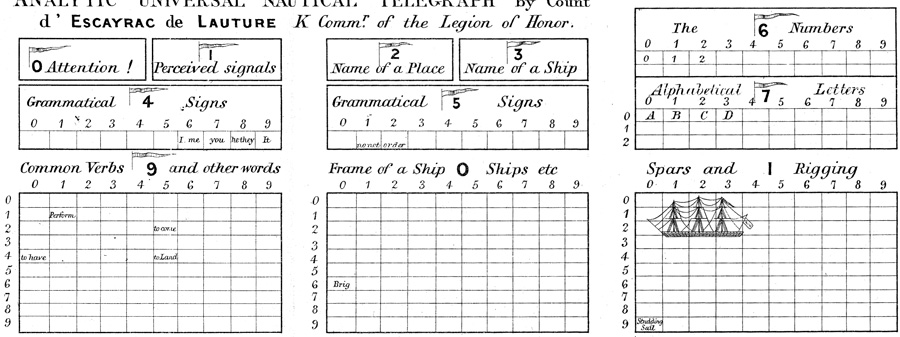
detail, signals and tables, Escayrac de Lauture, GB Patent No. 2602 Signalling
(1862)
Shown above are several of 20 tables that might be referenced to generate the following message. Figures are shown in red for the terms taken from the tables visible above; the entire set of tables is shown (at a further reduced size) below : —
I 46 / order 52 /preterite 820/ you 47 / to hoist 924 / fore top gallant 101 / studding sail 190 / you 47 / not 51 / perform 912 / it 49.
I’ll return to a discussion of switching
from one table to another to avoid confusion or what is known in cryptography as collisions
later. In this instance, tables 0 through 9 have their own respective indicator pennants, and the second set of tables 0-9 are indicated by figure penants.
The full set of (skeleton) tables, presented in Escayrac’s GB2602 (1862) is shown below.
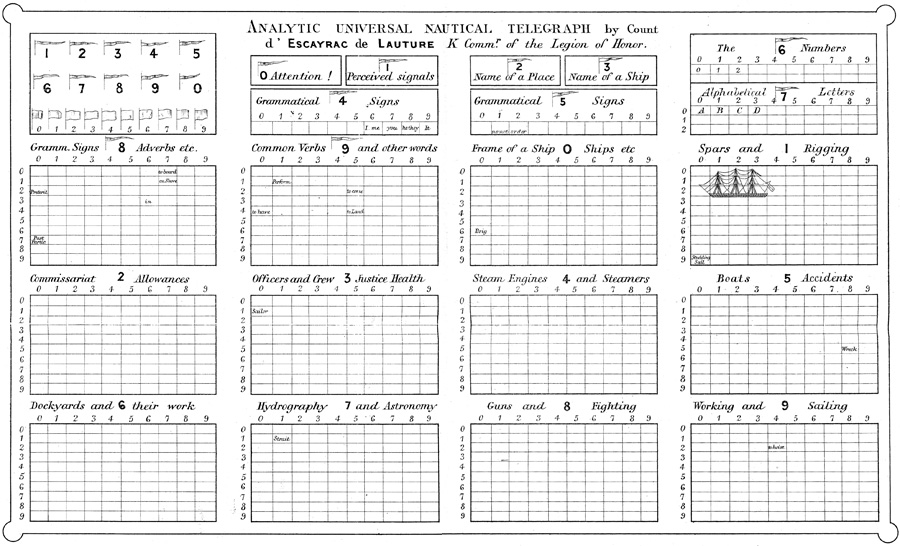
most of Sheet 1
, Escayrac de Lauture, GB Patent No. 2602 Signalling
(1862)
Note Table 1 Spars and Rigging
...
Shown below is a section of a table that is more fully populated with terms, in this instance not specialized (e.g., military) but common
words —
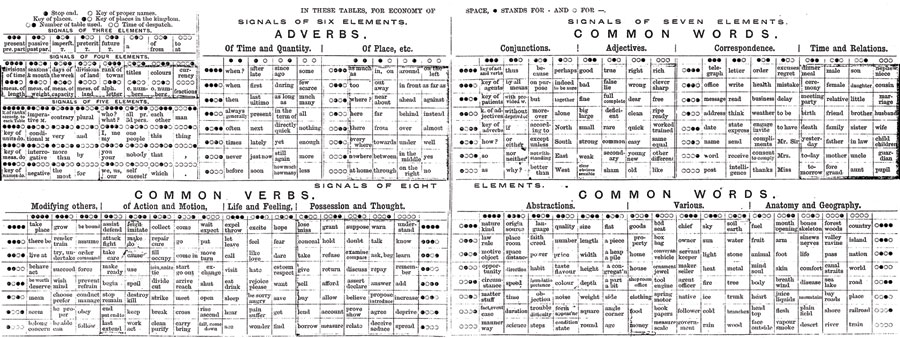
detail, signals of six, seven and eight elements, Common Words
(Abstractions and Various); Sketch of Tables (1863)
Zooming in —
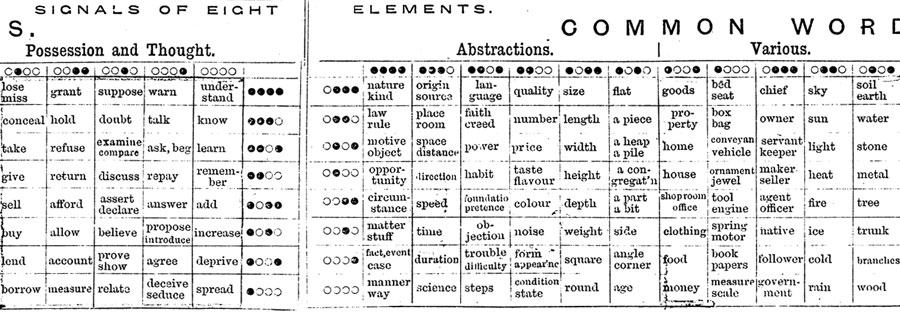
closer detail, signals of eight elements, Common Words
(Abstractions and Various); Sketch of Tables (1863)
The section abstractions
contains six columns, eight rows of terms. We find quality
next to size
, number
next to length
, taste/flavour
under price
and above colour.
Questions arise. Does opportunity
relate to circumstance,
as direction
to speed
? Is weight
to side,
as square
is to angle/corner
? Are opposites consistently handled by a separate table of auxiliaries and the like? (For example, in the eight element
table for common verbs, we find like/love
in a cell above hate,
and rejoice/please
in a cell above be sorry/angry
).
What method lies behind the arrangement of these 67 terms in these 48 fields
?
Whatever method there is, appears to be rough-and-ready. Yet our expectation that there would and should be something more, some more orderly conjugation of terms, may only be an artefact of the tabular arrangement itself. Its seeming order disposes us to look for more system than is warranted: the x-y table facilitates coding, and maybe finding, but it may not represent a 48-step calibration of abstractions. Whether or not the terms are arranged systematically may depend on the degree to which a vocabulary associated with a particular domain lends itself to systematic treatment.
The table shown above, with its pragmatic (good-enough) distribution of phrase elements, is not what one typically finds in telegraphic codes for specific domains. In cotton codes, for example, cells indicate the intersection of two different orientations (or facets of meaning). The cell of that intersection contains a unique codeword that also, efficiently, provides an address by means of which the message receiver can find and unpeel those facets).
For example —
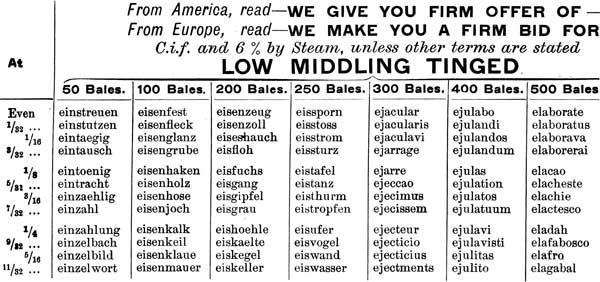
detail p306, Meyer’s Atlantic Cotton Code (37th edition, Liverpool, 1895)
In the above, facets are distributed evenly across the top row and left column, as if calibrations on a ruler. The table itself might represent yet another facet of meaning (here, low middling tinged,
rather than some other classification); the position of the user (Europe, America) would indicate yet another facet of meaning (offer or bid, respectively).
Escayrac’s phrase vocabulary is arrayed differently, in something like what we might today call a cloud,
one term surrounded by others in a semantic magnetic field or neighborhood, whose underlying rules might have more than one principle. His tabular format is not as rigorous as it seems. It is necessary for coding, because each term requires a unique x-y coordinate. It is not used in rigorous classification of subject, however, and certainly nothing like Meyer’s low middling tinged
offer-bid table. It is closer to Roget’s Thesaurus (1852), where logical/semantic rigor is perhaps high in the synopsis of categories,
but gives way to weaker associations at the lower word
level.
Escayrac imagines that a dozen vocabularies should be sufficient, each able to be memorized by clerks operating in the respective domains. Here are some more examples, from Sketch of Tables (1863) —
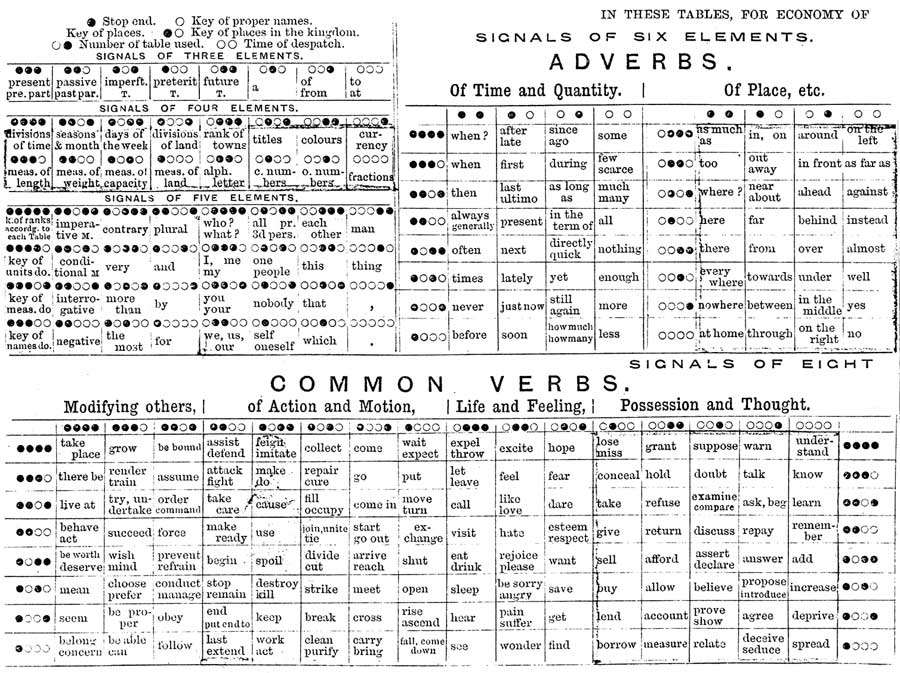
detail, signals of six, seven and eight elements, Sketch of Tables (1863)
aside : on switching among multiple tables
In practice, the system suggested above would require indicators before each term or sequence of terms drawn from the same table, directing the user to the relevant table. Alternatively, a single key
or indicator
codeword could direct that a following sequence of ciphers be translated from tables A, C, D, G and B, in that order.) Codewords of this sort, that provided a protocol for looking up a fixed sequence of following codewords (or cipher components), were used in specialized figure codes of later years.
more on tables
I’d like to juxtapose two observations, about tables and about topical dictionaries, and then make some observations about Escayrac’s ideas about signalling and telegraphy.
Tables facilitate the selection, categorization, checking, and extraction of data — but there are as many different applications of mathematical tables as societies which used them.
from introduction, Campbell-Kelley et al, eds, History of Mathematical Tables (2003 : 3)
In terms of communication theory we can say that alphabetical dictionaries serve the needs of a receiver of a linguistic message
and that topical dictionaries serve the needs of a sender of a linguistic message.
Werner Hüllen. English Dictionaries 800-1700 (1999 : 11,15)
The first passage concerns mathematical tables, but expresses the essential, systematizing role of tables. Escayrac adapted an idea of tabular presentation of Chinese, itself derived from his universal analytic system.
The second passage captures the dual function of telegraphic codes : they serve senders and receivers of messages, and must make message components findable in two different ways : semantically (arrangement of phrases), and alphabetically (the code equivalents of those components). There are essentially two lists: of phrases and of code equivalents. The lists are linked, and each list is navigated by different means.
The arrangement of phrases in tables
goes back to John Wilkins.
(The same treatise proposes a system for a nautical telegraph, differing from the former by the nature of its signals (ten streamers and ten flags), rather than Morse or other signals.)
It must include, in addition to a vocabulary, a system of grammar as well. A philosophical and thorough study of language has led me to the conclusion that language everywhere, and always, passes from a synthetic to a more and more analytical form; that different nations brought into contact, come, in order to understand each other, to a simplification of their grammar, which becomes the more analytical in the same ratio as those nations are more amalgamated with others, as their empire is of greater extent, their civilization more ancient and of a higher development...
(Analytic pp4-5)
Simplification of grammar means creation of an algebraic
separation of tenses, persons, auxilliaries, each indicated by a unique sign that could be appended to any verb.
Escayrac was working these ideas in a provisional way, and these documents are probably best understood as prospectuses, their details still to be worked out. He invites input. His Short Explanation (April 1863), which is devoted to naval signals, concludes thus :
I am not a naval officer myself; I have composed these tables without any assistance, and first in a language which is not my own, and which I have but imperfectly mastered. It is, then, quite natural that they should be found extremely imperfect. My excuse is, that they are not intended for actual use, but only submitted as a first sketch to the examination of nautical men. ¶ I will receive very thankfully any observations they will have the kindness to address to me... He seeks in particular, their remarks on the signals themselves, useful words omitted in
and useless words introduced
in the tables, and general improvements.
Escayrac’s tables may bring to mind Roget, both the clouds of expressions brought together under his topics, and the tabular synopsis of categories
that underlies his Thesaurus of English Words and Phrases, Classified and Arranged so as to Facilitate the Expression of Ideas (1852). Escayrac may have overemphasized the signals, and underestimated the challenge of arranging words and phrases in a systematic way. But it was not his ambition to subject the entire English language to his system; specialized vocabularies would suffice. He writes
The wants of the telegraph are limited; its task is special; it does not require a perfect instrument, but a tractable and commodious instrument; it must have its own language, which places itself between our vulgar idioms and that higher form of language which our mind can conceive. (Analytic Universal Telegraphy (December 1862, p16))
the tekachotomical method
A remarkable — but optional — feature of Escayrac’s telegraphic ideas was the nestling of ideas/phrases in squares within squares within squares.
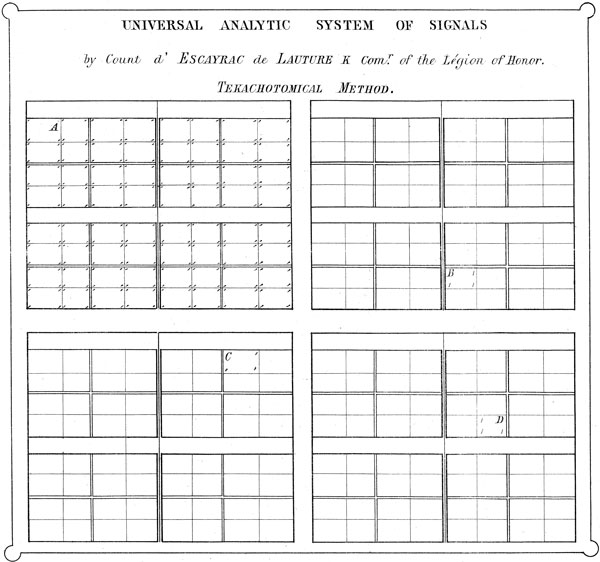
detail, drawing sheet 2, Escayrac de Lauture, GB Patent No. 2602 Signalling
(1862)
The basic unit is a square with four quadrants, or cells, numbered 1 2 (in the first row) 3 4 in the second. Four-cell squares nestle into quadrants of a higher-level square, conceivably ad infinitum, yielding 4, 16, 64, 256 (as displayed above), and ultimately 1024 cells. Each figure, in sequence, indicates a quadrant. Escayrac provides the translations for the words represented by A, B, C and D above, as follows:
A 1, 1, 1, 1, 2
B 2, 4, 3, 1, 1
C 3, 2, 2, 1, 1
D 4, 2, 3, 4, 2
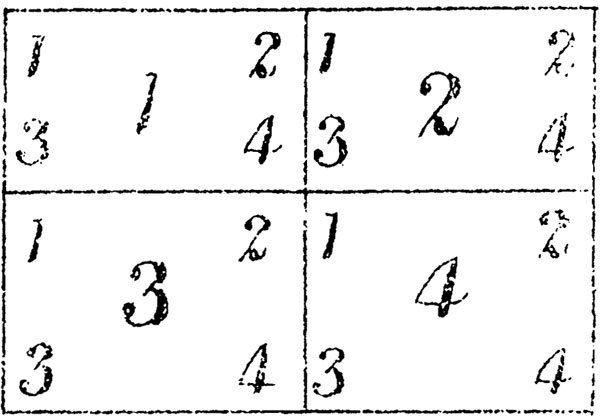
detail, drawing sheet 2, Escayrac de Lauture, GB Patent No. 2602 Signalling
(1862)
Shown above, we see four quadrants in one square, within each of which four next-level quadrants are shown. Escayrac reserves this idea for accessory ideas, grammatical signs, letters, figures,
separate from the specialized vocabulary tables described earlier. The system appears not to be intended for analytical presentation of topics, therefore, and no lexical or semantic details are suggested for it. And yet, it brings to mind the idea of semantic networks,
or graphs for the structure of meaning. One can imagine how Escayrac’s tekachotomical squares might be elaborated into a structured, faceted system of meaning (J. L. Jolley’s holotheme
comes to mind).
The expression Tekachotomical
presumably derives from the Greek θήκη (box), perhaps with a whiff of tachy (for swift/speed). Chotomical
suggests division and/or classification: dichotomy derives from Greek διχοτομία to cut in half.
The system, — and Escayrac’s more elaborate subject tables — are a variation of a Polybius Square, although as we shall see, the tekachotomical
method has a different derivation.
Escayrac also offers a hand-writing version of the tekachotomical method.

detail, appendix Explanation of the four elementary signal-tables
, Escayrac de Lauture, Analytic Universal Telegraphy (1862)
The hand-writing form shown above is one of two that Escayrac proposes. The second form shown above, almost certainly was impractical, but is one reason why Escayrac’s books are listed among handbooks on shorthand and tachygraphy. It is to be noted that the figures shown here, are not in the same order as given in GB2602 (1862). Here they arranged by column, rather than across rows.
But the system, at Escayrac’s own admission, was in flux. It derives from Escayrac’s understanding of written Chinese, particularly as refracted by Marcellin Legrand.
Chinese
It is important that the telegraph, which is for the human species what the nervous system is for the individual man
— reach, and flourish within, China. But means must be found to accommodate the telegraph to the Chinese language, lest it be suited only to transmission of European dispatches alone.
Escayrac’s ideas about Chinese appear to have been the source of his ideas about analytical universal telegraphy. This section draws mainly from his On the Telegraphic Transmission of Chinese Characters (May 1862).
Escayrac begins at the beginning: Daniel J. Macgowan’s Bowu Tonsgu (Philosophical Almanac) (1851) that contains, apart from its Christian proselytizing content, short chapters on electricity, galvanism and telegraphy (it concludes with several pages of an almanac). Its discussion of telegraphy provides what apparently is Macgowan’s own idea for a dial-telegraph suited to Chinese characters. Escayrac has seen not the original work — which in any event is in Chinese — but a review of it, that appeared in The Chinese Repository in May 1851. Macgowan’s idea, using by means of the English dial-plate telegraph, a kind of telegraph now pretty generally condemned,
permits transcription of Chinese characters, stroke by stroke.
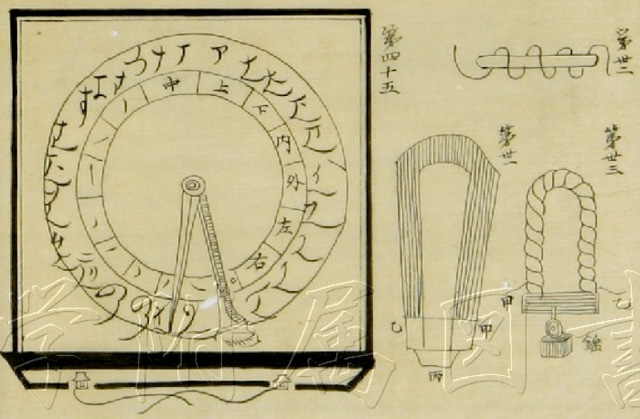
detail, illustration no. 45, page opening 10, of Daniel Jerome MacGowan (1814-93), Philosophical Almanac or Philosophical Yearbook (1851), this being from a manuscript copy at Nagasaki : 瑪高温 (マックゴワン) 訳述、咸豊元年(1851)寧波耶会出版。写本、一冊。電気通標序、第一章は緒論、第二章は電気ガラス器、第三章は電気五金器、第四章は磁石両極、第五章は磁石電流、第六章は電気通信を述べている ; scans here
From another copy —
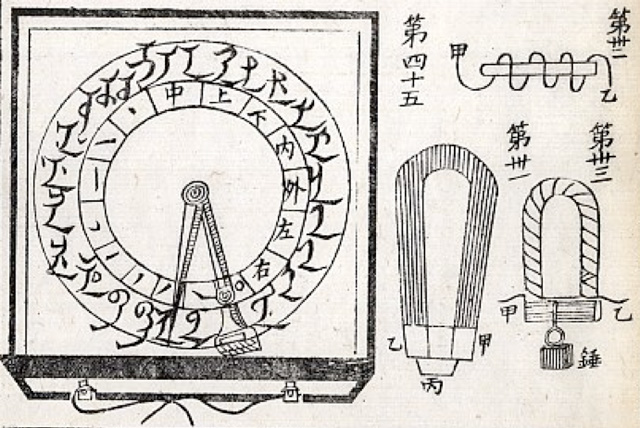
detail, illustration no. 45 of Daniel Jerome MacGowan (1814-93), Philosophical Almanac or Philosophical Yearbook (1851) at National Library of Australia : Bo wu tong shu Ma Gaowen yi shu, published: 880-02 [Ningbo] : Zhen shen tang, Xianfeng yuan nian [1851]; scans here
Macgowan’s dial is described in a review of his Philosophical Almanac in The Chinese Repository 20:5 (May 1851), pp 281-285 :
The plan by which he proposes to convey telegraphic communications in Chinese is to prepare a round dial plate, with a needle in the middle, which points to sixteen different partitions, and by combining the strokes there referred to, the character will be formed. Two characters, tung and si (east and west), are employed to denote the form and the location of the strokes.
The following list is derived from that review; in each case, needle movements are indicated first, followed by location or stroke type. (I show the strokes where unicode exists for simple characters formed from them.)
pointing east once, top;
pointing west once, bottom;
once east, once west, inside;
once west, once east, outside;
twice east, left;
twice west, right;
twice east, once west, 丶 point
twice west, once east, 一 stroke
twice east, twice west, 丨 perpendicular
twice west, twice east, 亅 or 勾 a hook
thrice east, once west, [ no unicode (upper SW of dial) ] a catch
thrice east, twice west, [ no unicode (middle SW of dial) ] a curve
thrice west, once east, [ no unicode (lower SW of dial) ] a nail
thrice west, twice east, 乁 a sweep
thrice east, thrice west, middle
thrice west, thrice east, Ο a circle or division
The Chinese Repository review concludes that communications in Chinese can only be intelligibly conveyed by describing the characters in some such way as Dr. Macgowan here proposes.
[ here ]
Escayrac assesses what he (pretty correctly) understands of the system, and concludes that, while not ideal, it is on the right track, and certainly a better track than another in which each character was given its unique number. To arrive at something more simple, we must have recourse to an analysis of the characters. The whole question is to know into what elements they may be reduced, and whether it is indispensable to descend even to the strokes of which the characters are composed.
He will want to avoid mapping strokes, and look instead for other principles. The principle that suggests itself consists of radicals and phonetic elements, the combination of which accounts for 95 percent of all Chinese characters. There are 214 radicals, about 1,400 primitives. Escayrac uses the term key,
which I take (from Morrison also) to mean radical.
It is here that Escayrac brings in the composite printing method developed by Marcelin Legrand, in which characters are decomposed to their radical and phonetic elements.
Punches and matrices are made of these, the type from which can then be combined to form characters.
Because of the diversity of forms
taken by radicals or other element, depending on their position within character, Legrand must have engraved 4,220
individual sorts (i.e., individual printing types). (Another description — Exhibition of the Works of Industry of All Nations 1852 (Class XVII. Report on paper and stationery, printing and bookbinding) — puts the total at 4,600 (here).) Apparently, some materials were printed with Legrand’s font by the American Presbyterian Mission.
While Marcelin Legrand’s impressions are rather thin,
(5), his system has been received with extreme favour,
writes Escayrac. Each element has its number, so that the composition of a single character is simply done by a workman. It is not difficult to comprehend that if, instead of writing these numbers, one should transmit them by telegraph, one would transmit an irreproachable Chinese despatch.
Escayrac then brings the signal aspect into play: Instead of transmitting numbers, one might moreover transmit simpler and shorter signals.
[This is akin to transmitting pictures, one element at a time, as will be proposed later by Montagna, Mortier, Ellero and Gaynor (see elementary signs : pictures 1
here)].
But Marcelin Legrand’s combinatorial system rendered characters of uneven quality and a lack of grace that doomed them as a practical system.
Fortunate, the question is simpler for telegraphic transmission than for typography. In consequence of the diversity of forms, which, according to its position, the same character radical or phonetic may receive, Marcelin Legrand must have engraved 4,220 different types. Telegraphy, considering the elements, without taking into account the appearance assigned to them in writing... need only occupy itself with about 1,400 characters.
(6)
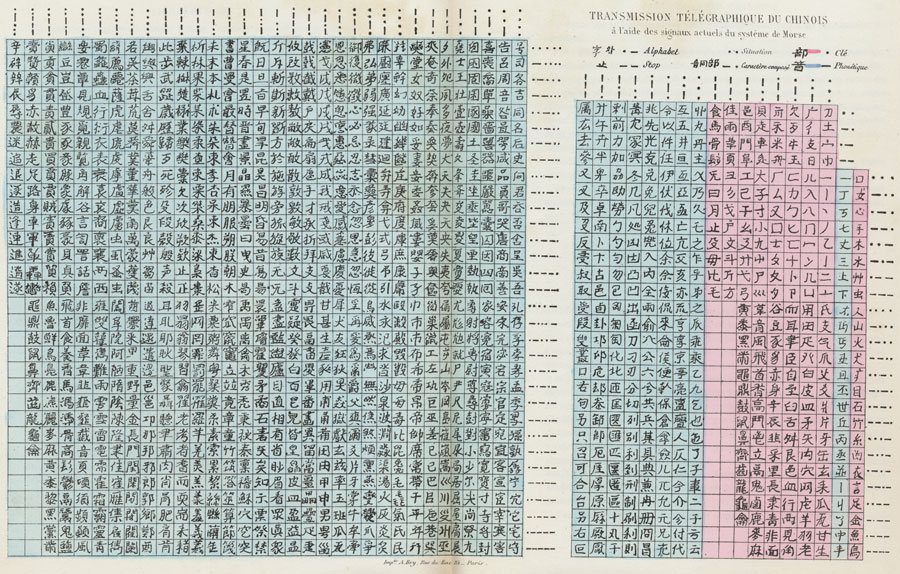
Transmission Télégraphique due Chinois à l’aide des signaux actuels du systèe de Morse,
ex Le Langage: Son histoire, ses lois, applications utiles de ces lois (Paris, March 1865)
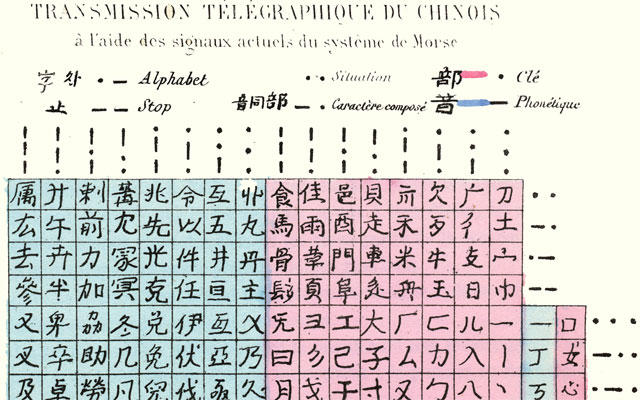
detail, Transmission Télégraphique due Chinois à l’aide des signaux actuels du systèe de Morse,
ex Le Langage: Son histoire, ses lois, applications utiles de ces lois (Paris, March 1865)
The table shown above organizes components in their radical and phonetic functions, but arrays them by the conventions of Morse code. We have seen this also in Escayrac’s Sketch of Tables (1862).
We arrive at Escayrac’s 1862 table (in De la transmission télégraphique and its Englished version, both published in 1862. This departs from Morse, and embraces the tekachotomical
method discussed above, in which four-quadrant tables are nestled within quadrants nestled within quadrants: yielding 4, 16, 64, 256, 1,024 and even 4,096 cells. It was suggested by the two-line Bavarian telegraphic system, involving elementary signals of point and dash, placed at one time on one line; at another, on another.
(7) (I’ve encountered descriptions of the Bavarian system that differ, suggesting one line — no return circuit — involving polarities, similar to what was done with submarine cable.)
Shown immediately below is the full table from the De la transmission télégraphique des caractères chinois (Paris, 1862). This uses the tekachotomical table system that replaces the Morse shown in the (1865) example above. The particular signal system employed is not so important, except that the square-within-a-square system does provide certain visual scanning advantages — related perhaps to chunking
that is part of memory and cognitive processes.
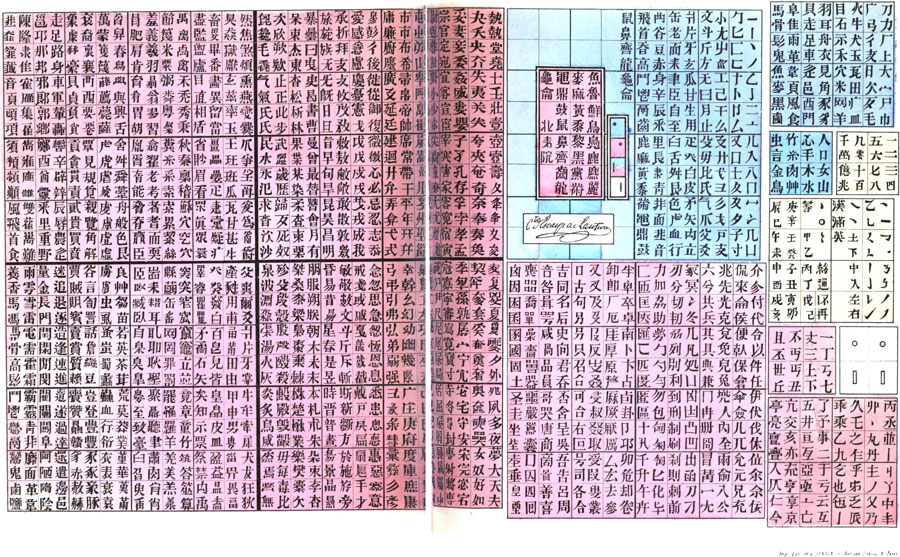 full table (Google Scan, Michigan copy), De la transmission télégraphique des caractères chinois (Paris, 1862)
full table (Google Scan, Michigan copy), De la transmission télégraphique des caractères chinois (Paris, 1862)
Radicals and phonetics are arrayed in squares of different colors, as follow —
- In blue, at upper right, are
16 radicals to be written with two elementary signals, [serving] to compose 13,950 characters out of 30,000.
- Also in blue,
a second group, composed of 64 radicals to be written with three elementary signals;
- In yellow, conventional signals;
- Most of the table — in red — are the phonetics, which are
ranged according to the order of the radicals which serve to form them and the number of their strokes.
It can be seen from the display that these are arraged also in four tables of 16, 64, 256 and 1,024 characters. A few additional phonetics are shown in a small cartouche. - There are also collected into two groups of 16 and 64 characters certain conventional signals, e.g., the numbers, the elementary strokes for writing, and certain indicators (e.g., signs of punctuation, indication of language employed, etc.)
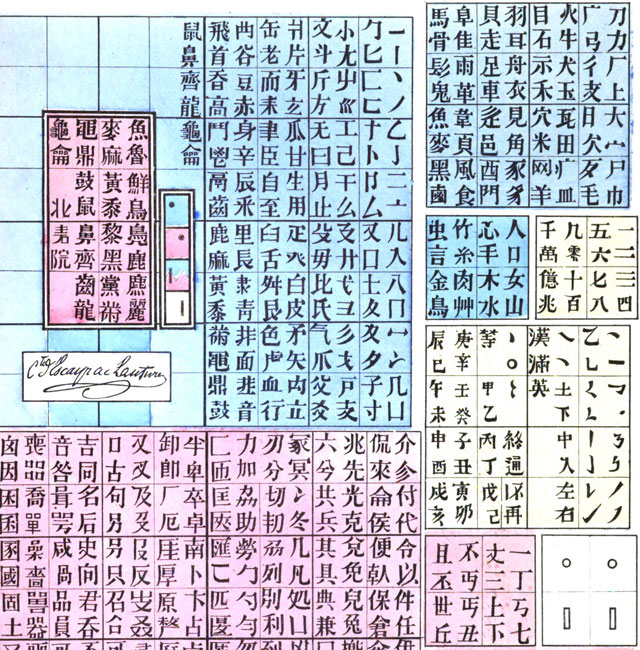
detail, upper right of table, De la transmission télégraphique des caractères chinois (Paris, 1862)
Note the small square (below the yellow squares, at bottom right of the detail above) showing dots at NW and NW quadrants, and vertical lines at SE and SW. These are the four elementary signals.
Coding —
Shown below is Escayrac’s example of coding for a message meaning It is reported that there are some disturbances in the district of Shang-hai,
reading column by column, from the right. Looking closely at the code, which has the appearance of Baudot (five-unit) code tape, we see that each row (or row pair, for vertical lines indicationg SE or SW) contains an elementary symbol, and is separated from the next by a blank space (row); two blanks (now I’m transcribing from Escayrac) —
...shall be left between these signals and the elementary signal destined to designate the class or radicals, phonetics, etc., to which the signalised character shall belong; in fine, four blank spaces shall be left between the words.
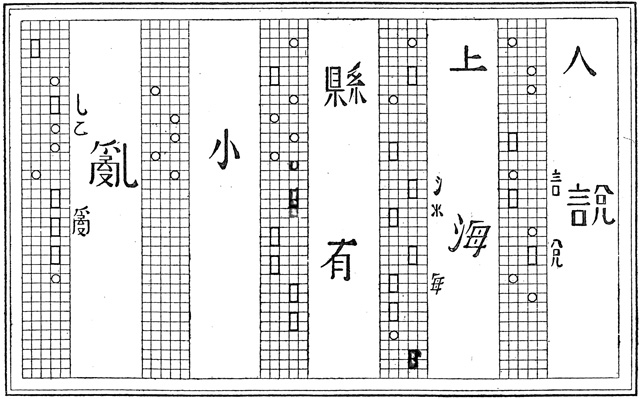 detail p10, On the Telegraphic Transmission of the Chinese Characters (Paris, May, 1862). Note handwritten corrections to the code, in this copy at Cambridge University.
detail p10, On the Telegraphic Transmission of the Chinese Characters (Paris, May, 1862). Note handwritten corrections to the code, in this copy at Cambridge University.
I’ve reformatted the example message to present each of its eight characters, accompanied by Escayrac’s own explanation.
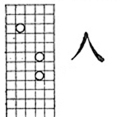 | The first character... is a radical. I mark then a point to the left, I leave two blank spaces, and the character being in the table of the sixteen most important radicals, in the upper division to the right, and, in the upper right hand angle of this division, I inscribe at the distance of one blank space from each other, two points on the right. |
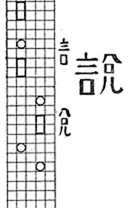 | The second character is double, that is, it is composed of a radical, which is on its left, a normal situation, in respect of the phonetic which accompanies it, and of a phonetic which is on the right; I mark first, by a line on the left that the character is a compound one. I leave two blank spaces, I inscribe the radical without any preliminary signal, and after two blank spaces, the phonetic, likewise without a preliminary. |
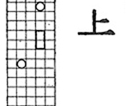 | The third character is a phonetic, which I make known by the aid of a point placed at the right; after two blank spaces, I mark its position by the aid of two signals, because it is to be found in the square of the sixteen first phonetics in the lower division on the right, and the upper angle on the left. |
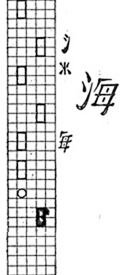 | The following character is a compound one; its radical is presented in an abridged form; its entire form is reproduced below the insulated radical, on the left and towards the top of the character. |
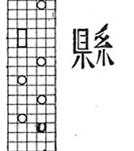 | The fifth and sixth characters are phonetics, |
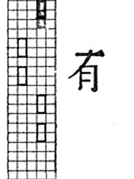 | |
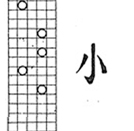 | the seventh is a radical, |
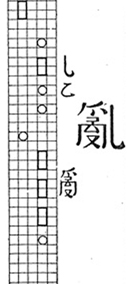 | the eighth is a double character, the key of which is placed on the right, which is its normal position. |
Shown below, same presentation (sans holograph corrections) from the French original.
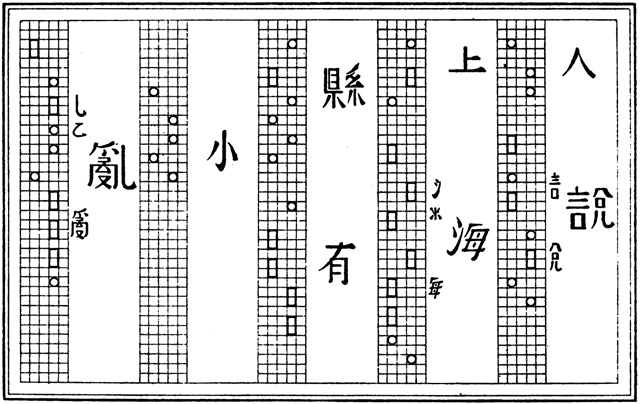 detail p7, De la transmission télégraphique des caractères chinois (Paris, 1862)
detail p7, De la transmission télégraphique des caractères chinois (Paris, 1862)
Escayrac continues the discussion of his system by pointing to its economy. It requires an average of but six simple signals are required for each character, compared with 12-16 compound signals in a system in which each stroke is described successively (its form and its position in a compound character). (He does not discuss the Viguier system of numbered characters.) He proceeds to consider the actual preparation of messages for transmission, prior to delivery to the telegraph office, and concludes with the suggestion that his system might yield a universal telegraphic language of sorts, provided that the underlying tables were available in English, Russian or French translations.
afterlife —
Escayrac’s ideas about telegraphic transmission of Chinese did receive some notice, but seem to have been dismissed. (His ideas about universal telegraphy received little or no notice at all.) An 1874 review of Viguier’s Table for transmitting Chinese despatches by telegraph (1871), and of Escayrac’s On the Telegraphic Transmission of the Chinese Characters (1862) compares the latter quite unfavorably with Viguier. It’s so nicely framed, however, that I transcribe some of it here:
...The brochure of the Count d’Escayrac de Lauture, fourth in our list, exposes a system on quite a different basis. With a somewhat complicated arrangement of Tables including all the necessary characters, he lays down the most remarkable system of interpretation... ¶ We must leave our readers to form their own opinion as to the Count's invention. He gives as an example of a sentence written out by his code, 2,23443. 2,23433. 2,44442. 2,12. 2,3441. Of this he says the table will give the following translation: — I, me, next, day, no, /not, go. His method of notation is strongly suggestive of the Universal Language invented by Bishop Wilkins, a learned man, who among other improvements invented an apparatus to enable people to fly. As an example of the advantage of his philosophical language, the good Bishop proposes to write, instead of the word Goat, the symbols — Be. II. 2. A. The interpretation of which is that—
Be. means the genus BEAST, II. signifies the second difference, 2. is the second Species, and A. implies that it is joined as an Affinis to the Species.
¶ Very far removed from such vagaries is the common-sense practical table of Mr. Viguier...
ex Notices of Recent Publications,
The Chinese Recorder and Missionary Journal 5:1 (Jan-Feb 1874). [ here ]
Viguier’s system involved assigning a 4-numeral figure to every one of 6900 characters, the figures to be transmitted by telegraph. This system and its derivatives was and would remain the norm (indeed, something like it is embodied in unicode, itself an extension of ASCII and earlier telegraphic alphabets). The unnamed reviewer is correct, of course, in likening Escayrac’s system to Bishop Wilkins’s Universal Language
— that is its true genealogical precedent. It is also a main point of interest.
Links to the 1871 and 1872 versions of the Viguier tables can be found via my (unevenly) annotated list of scanned telegraphic codes [ here ]. The 1871 edition was produced by the Great Northern Telegraph Company.
Some of these ideas, derived by Escayrac from the earlier work by Marcelin Legrand and D. J. MacGowan, would have an afterlife in the development of the Chinese typewriter. One such instance is the typewriter developed by Lin Yutang (1895-1976), better known perhaps for his literary production than for his invention. His typewriter (US2,613,722, 1952) involves the separation of characters into two components: (1) 70-80 left-hand components (each forming a single character), and (2) combinations of right-hand units.
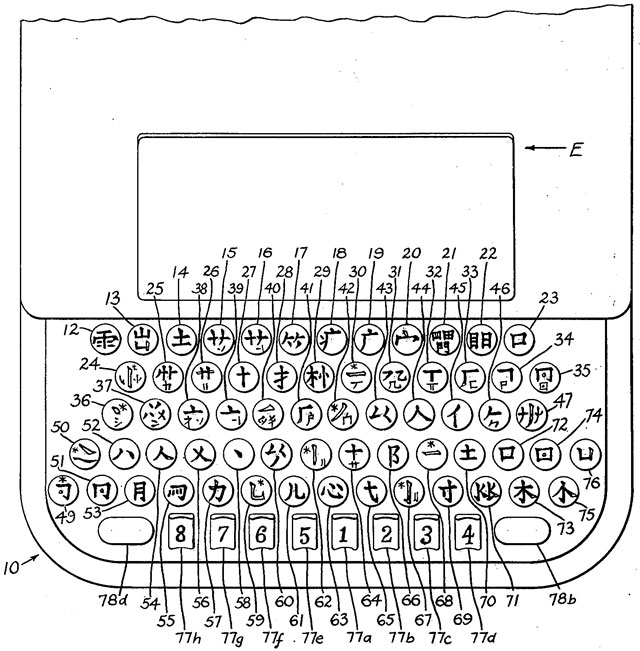
detail, Figure 2 of Lin Yutang, (US2,613,722, 1952) Chinese Typewriter.
E
is the display window; keys 12-76 show basic left, top and bottom components; the figure keys at bottom are the printing and selecting
keys, used to select from displayed alternatives for a given configuration.
All of these are contained in drums containing some 1,300 types (the ordinary Western typewriter uses, of course, type bars). The typewriter mechanism shifts the paper carriage to the next (succeeding) space only after both left and right hand components components ‐ the full character — have been printed. The important feature of the patent is that once a left-hand component is selected, there is displayed at the top of the machine the various top configurations
of the left hand component, from which one can select. A similar operation takes place for the right-hand components, where a visible index disclosing all of the components or characters having the same top and bottom configurations as those on the depressed keys
is displayed, usually consisting of one to eight (average 4) characters or components.
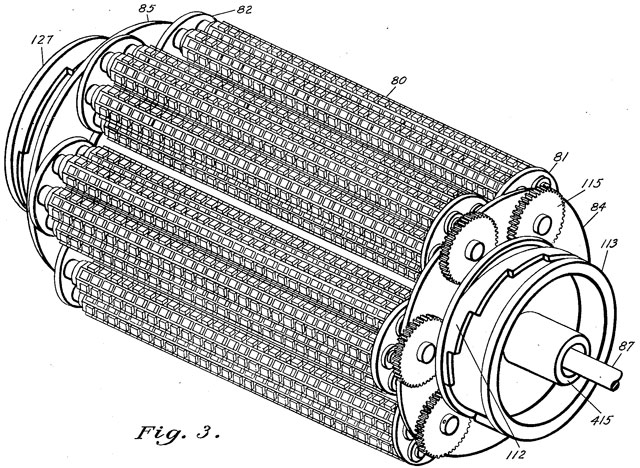
detail, Figure 3 of Lin Yutang, (US2,613,722, 1952) Chinese Typewriter.
This shows the type drums, containing some 1,300 character components.
It is not my purpose here to elaborate on Lin Yutang’s typewriter, but only to point to it as a later manifestation of ideas current from Escayrac and his predecessors. The important ideas were: analytical breakdown of character components, and display of those for selection. Escayrac’s ideas for telegraphic transmission of Chinese did not end there, but (in my view) were the origin of his ideas about tabular presentation of topics
to aid selection and transmission — in the panoptical displays discussed above.
Escayrac de Lauture, his life
n.b.: (unfinished) draft of a draft —
Pierre-Henri Stanislas Escayrac de Lauture — scholar, writer, explorer — was born in Paris, 19 March 1826. His family was an old and distinguished one in Quercy; forbears had fought in the Crusades.
He studied at the college of the Oratoriens at Juilly, where he demonstrated a facility for absorbing languages, including Latin and English. Durand-Lapie mentions that he also picked up Portuguese (from Brazilians studying there) and Spanish, as well as an interest in foreign lands and cultures, and a desire to see them.
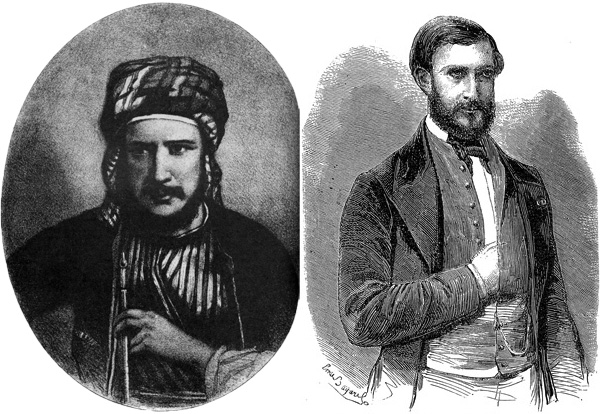
left: portrait d’après une photographie de Mayer et Pierson
, ex Camille Martinet, L’otage des Mandarins (Paris: Editions France-Empire, 1989). Mayer et Pierson produced cartes de visite. Archives here (Archives départementales du Haut-Rhin).
right: ex L’Illustration, Journal Universel. 26 January 1861, p52. The accompanying text (in la Revue politique de la semaine runs: Nous donnons dan notre numéro de ce jour le portrait de M. d’escayrac de Lauture, qui a subi un si indigne traitement pendant sa captivité en Chine. M. d’Escayrac ne peut plus se servir de ses mains, par suite des courroies qui ont tenu ses poignets serres pendant douze jours. On annonce que le jeune savant revient en France.
(partial translation: Having been subjected to cruel treatment during his captivity, including having his hands bound for 12 days, Escayrac could no longer use his hands.
He entered the Ministry of Foreign Affairs as an attaché in 1844, and served on board the corvette Berceau in a punitive expedition (with the British) against Madagascar. He took copious notes. During that trip, he visited Sainte-Hélène, the Comores and Zanzibar, and other islands. He returned to France in 1846, and was assigned to the French Mission in Spain, and the French legation in Lisbon. From there, he was able to pursue the study of natural history in Morocco, and aso visited Algeria. He used the Revolution of 1848 as a pretext to leave his diplomatic career, and to commit himself solely to his studies and expeditions. He toured through Britain, Germany, Switzerland and Italy, and traveled to Tunisia in 1849. 1850 finds him in the deserts of Libya, and then in Cairo. He traveled in the Sudan and Darfur. He returned to France in December 1850, where he met Edme Jomard, a geographer who had participatedin Napoleon’s expedition to Egypt, who was impressed by the young man and saw that he was admitted in 1851 as a member of the Geographical Society, in whose bulletin a number of Escayrac’s papers were published.
Escayrac traveled through the Holy Land in 1851-53, publishing in the latter year his Le Désert det le Soudan. Études sur ’Afrique au nord de l’équaeur, which earned him the Legion of Honor at the age of 27. He returned to Cairo in 1854.
Escayrac had gone to China in 1859 as a member of an Anglo-French force that was dispatched during the Second Opium War. It happened that Escayrac was part of a smaller group of French and British who, en route to negotiations in Beijing, were seized and imprisoned; he himself was tortured, apparently by having his hands bound by tourniquets that would eventually have lead to their severing. Escayrac was one of the party who were eventually freed. He returned to France thereafter, but was in declining health — and without the use of his hands — until the end of his life.
Escayrac’s publications on telegraphy
All of the publications listed below appeared immediately before or during Escayrac’s time in England (late 1862 through early 1867).
- De la transmission télégraphique des caractères chinois, Paris: impr. de J. Best, 1862, 16 p.
Also published as On the telegraphic transmission of Chinese characters: a table with four elementary signals, and another according to Morse’s signals, by John Camden Hotten; have not seen. - On the Telegraphic Transmission of the Chinese Characters (Paris, May, 1862 / Paris.—Printed by E. Brière, 257, Rue Saint-Honoré.
The text is not the same as that in Transmission Télégraphique des Charactères Chinois, particularly in the opening section. It is somewhat loosely written/translated, perhaps from an oral presentation by Escayrac to his brother. The two versions are closer to each other in their later sections, however, where the tabular arrangement is given more attention.
- GB2225, 8th August 1862. Signalling.
- GB2602, 24th September 1862, Improvements in Signalling.
- Analytic Universal Telegraphy, subtitled
an international telegraphic language, simple, accurate, and three times shorter than the system at present in use, presenting in its practice neither the difficulties nor inconveniences of other ciphers
(London, John Camden Hotten, December 1862) - Grammaire du télégraphe, histoire et lois du langage, hypothèse d’une langue analytique et méthodique, grammaire analytique universelle des signaux, 1862.
Have not seen; is discussed in Michel Wiedemann,L’imaginaire de la réforme de l’orthographe en France au XIXe et au XXe siecle,
January 2010, here. - Short Explanation of the Sketch of the Analytic Universal Nautical Code of Signals (London, April 1863)
- Sketch of Tables [English] for the Analytic Universal Telegraphy, subtitled
composed, on the supposition of Morse’s instruments and signals being used
(London: John Camden Hotten, April 1863) - US39,016. June 23, 1863. Improvement in Telegraphic Signals
- Le Langage: Son histoire, ses lois, applications utiles de ces lois (Paris, March 1865; 83pp)
other sources
on Escayrac —
- Paul Durand-Lapie.
Le Comte d’Escayrac de lauture, voyageur et explorateur Français.
In Bulletin de Géographie Historique et Descriptive 19 (1899), 323-372
[ here ] - Paul Durand-Lapie. Le comte d’Escayrac de Lauture, Voyageur et explorateur français, commandeur de la Légion d’Honneur. Paris : Champion, 1899, 180 p.
Have not seen, presumably an expansion (or reprint) of the article in Bulletin de Géographie. - Camille Martinet. L’otage des Mandarins (Paris: Editions France-Empire, 1989)
- Broc Numa. Entry on Escayrac in Dictionnaire Illustré des Explorateurs et Grands Voyageurs Français du XIXe Siècle, vol. II, Asie. Paris, 1992. Cites Durand Lapie, as well as D.B.F. and Grand Larouse du XIXe s.
- Stanislas d’Escayrac Lauture (wikipedia page, contains a convenient bibliography)
related —
- On John Camden Hotten (1832-73), a colorful and energetic publisher and writer — a
general textual entrepreneur
as Simon Eliot puts it, see Eliot’s entry on Hotten in the Oxford DNB, (developed further in his
in Book History (2000) : 61-93. One wonders what the relationship was; Escayrac appears to have been keen to get his views patented and publicized in Britain and in America.Hotten, rotten, forgotten
?: an apologia for a general publisher - Martin Campbell-Kelly, M. Croarken, R. Flood and E. Robson, eds. The History of Mathematical Tables: From Sumer to Spreadsheets. (OUP, 2003)
- Werner Hüllen. English Dictionaries 800-1700: The Topical Tradition (Oxford, 1999)
further observations
Perhaps a box might be used whose divisions, corresponding to those of my tables, would contain, ready for the hand of the compositor, or let escape from under its pressure, types, either in perforate card-board, metal, or any other substance, each of which would represent one of my words, or my grammatical signals, and these adjusting or adapting themselves to each other, would reproduce with extreme rapidity the signals read on the table, and could, after a rapid revision, be transmitted to the automaton..
(Analytical) 1862: 13-14
One imagines a semantic tablet, akin to the shapewriter (once called Shark?), except that this would be not a form of alphabet-based tachyraphy (even predictive), but semantic, leading down through tabular layer after layer after layer of meaning aspects and predicates. As if bringing the predictive function to the writing surface (writing by selection).
1 December 2011.
- subject tables
- more on tables
- the tekachotomical method
- Chinese
- Escayrac de Lauture, his life
- publications on telegraphy
- other sources
- further observations
last edit 1 dec 11